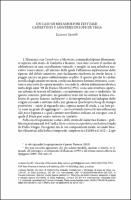Chapter Un caso di metamorfosi testuale: Castelvines y Monteses di Lope de Vega
| dc.contributor.author | GENTILLI, Luciana | |
| dc.date.accessioned | 2022-06-01T12:17:43Z | |
| dc.date.available | 2022-06-01T12:17:43Z | |
| dc.date.issued | 2020 | |
| dc.identifier | ONIX_20220601_9788855181501_449 | |
| dc.identifier.issn | 2704-5919 | |
| dc.identifier.uri | https://library.oapen.org/handle/20.500.12657/56266 | |
| dc.description.abstract | The subject of the essay is the analysis of the staging of Lope de Vega’s novel ‘Romeo and Juliet’ (Castelvines y Monteses), commencing from the tale of Luigi Da Porto (Venezia, Bendoni, 1530/31?), through the rewrite of Matteo Bandello (Novella 9, in Parte II, Lucca, Busdrago, 1554), and the french and spanish versions produced respectively by Pierre Boaistuau (Histoire Troisiesme de deux Amans in Histoires Tragiques, Paris, Sertenas, 1559) and Vicente de Millis Godínez (Historia tercera de dos enamorados, in Historias trágicas ejemplares, Salamanca, Pedro Lasso, 1589). The storyline up until its theatrical-transcodification, has been reconstrued through the analysis of a specific micro-sequence, the one of Juliet squeezed between Marcuccio’s cold hand and Romeo’s warm hand. The sequence is an example not only of the multiple echos and refractions of Da Porto and Bandello’s novels, but also of the intertextual dialogue, where repêchage is being used for surprising resemantizations (in Lope’s work, and after that in Molière). | |
| dc.language | Italian | |
| dc.relation.ispartofseries | Studi e saggi | |
| dc.subject.other | Lope de Vega | |
| dc.subject.other | Bandello | |
| dc.subject.other | Boaistuau | |
| dc.subject.other | de Millis Godínez | |
| dc.subject.other | intertextuality | |
| dc.title | Chapter Un caso di metamorfosi testuale: Castelvines y Monteses di Lope de Vega | |
| dc.type | chapter | |
| oapen.identifier.doi | 10.36253/978-88-5518-150-1.10 | |
| oapen.relation.isPublishedBy | bf65d21a-78e5-4ba2-983a-dbfa90962870 | |
| oapen.relation.isbn | 9788855181501 | |
| oapen.series.number | 209 | |
| oapen.pages | 19 | |
| oapen.place.publication | Florence |

